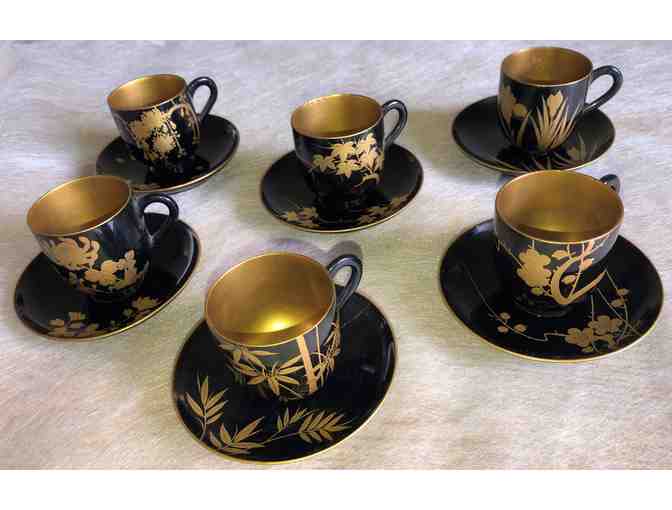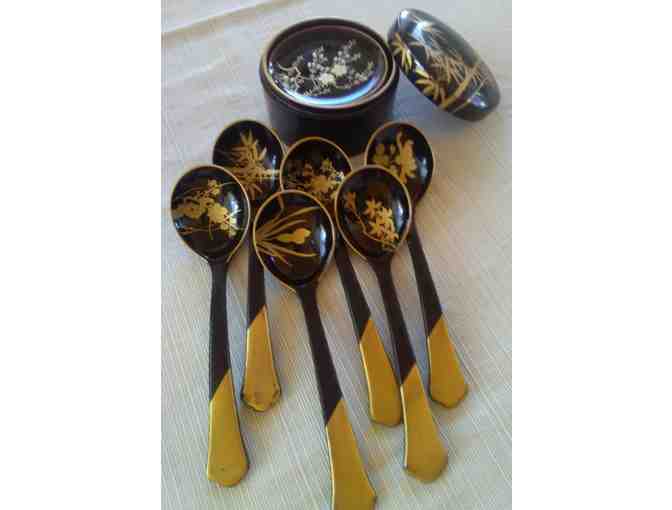Collectible Urushi (Japanese Laquerware) Set of 6 Tea Cups, Saucers, Plates and Spoons

Item Number: 111
Time Left: CLOSED

Description
Classic Collectible Japanese Urushi: This set of six tea cups and saucers in black with maki-e style gold designs were acquired in Japan about 80 years ago and are in exceptional condition. The matching small plates, covered container, and spoons are virtually a “match” but were acquired separately and several of the spoon handles show use.
What is this and why are they considered collector’s pieces? Urushi, or Japanese Lacquer, is a distinctive, highly prized art form refined for over 7,000 years. Cherished for its versatility, urushi has spread across all facets of Japanese culture from the tea ceremony to jewelry to modern abstract sculpture.
Decorated lacquerware is a process that originated in China more than 3,000 years ago and later spread throughout East and Southeast Asia. The spread of Buddhism from the ninth century inspired the production of a large number of decorative lacquered objects for temples and for the privileged classes.
In Japan, lacquer (raw sap) originally had a functional use as a varnish made from the sap of the urushi tree, also known as the lacquer tree which mainly grows in Japan and China. The lacquer tree must be tapped carefully as in its raw form the liquid is poisonous to the touch, and even breathing in the fumes can be dangerous. But people in Japan have been working with this material for many millennia, so there has been time to refine the technique. Once dried, it is perfectly safe.
The sap or raw lacquer, when flowing from incisions made in the bark of a lacquer tree, is a viscous greyish-white juice. The harvesting of the resin can only be done in very small quantities. Three to five years after being harvested, the resin is treated to make an extremely resistant, honey-textured lacquer. After filtering, homogenization and dehydration, the sap becomes transparent and can be tinted in black, red, yellow, green or brown.
After heating and filtering, urushi can be applied directly to a solid, usually wooden, base and is dried under very precise conditions. Pure urushi dries into a transparent film, while the more familiar black and red colors are created by adding minerals to the material. Each layer is left to dry and polished before the next layer is added. This process is very time-consuming and labor-intensive, which contributes to the desirability and high cost of traditionally made lacquer goods.
Some of the finer pieces of urushi – such as these particular items – are made through the process of maki-e. This thousand year old technique consists of sprinkling fine particles of gold onto the still wet lacquer. The resulting designs are set into place with further layers of polished transparent lacquer.
The gold dust is applied using bamboo tubes and small brushes made from rat’s hair in order to trace extremely fine lines. This 1500-year-old art calls for extreme expertise.
The fascination of Japanese lacquerware artists for the themes offered by nature (fauna, flora, natural sites, seasons, stars) is equaled only by their talent to magnify them in a poetic, pure and incredibly refined style. Each plant, mountain, animal, or star has a meaning. Among the favorite themes – replicated on this set of cups, saucers and matching mini-plates and spoons - are the plum, orchid, bamboo and chrysanthemum, which were considered by the ancient Chinese as the Four Noble Plants, each with its valued characteristic, such as purity (orchid), uprightness (bamboo), and humility (chrysanthemum).
Designs on this Urushi set: Orchid, Bamboo, Chrysanthemum, Plum, Cherry Blossom and Maple Leaf.
Special Instructions
The fortunate winning bidder for this item will receive an email to confirm pick up from Waimea Middle School, or it could be mailed to you at your expense. It is rather light weight. The items are sturdy but due to their value, would require careful packaging to protect the items during transport.